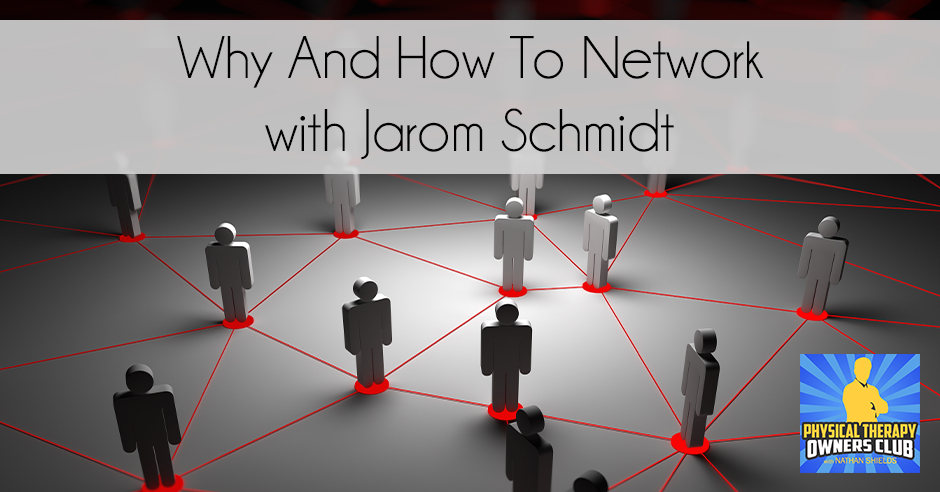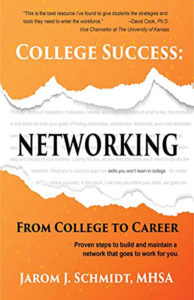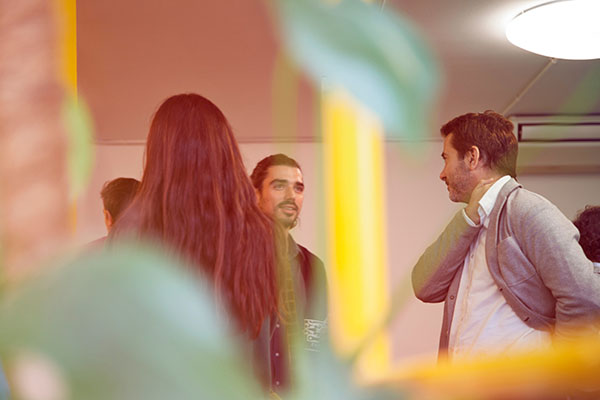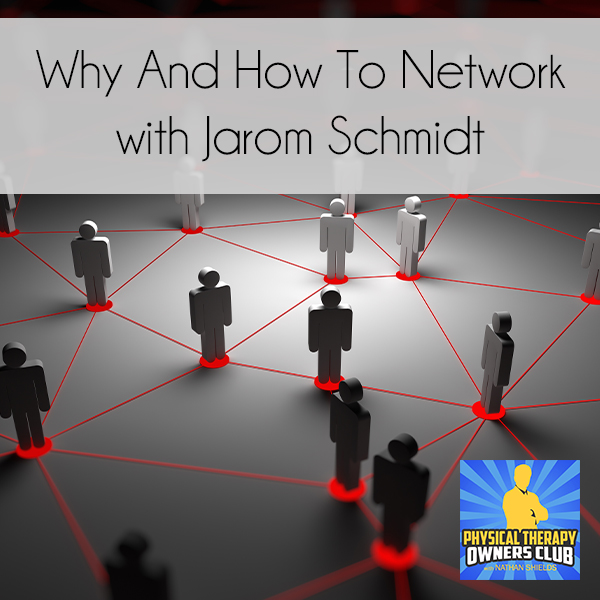
—
Listen to the podcast here:
Why And How To Network with Jarom Schmidt
This episode is unique in that it is the first episode I believe in which we’ve discussed networking. That’s one of my three main action items in the mantra, “Reach out, step out and network,” yet we haven’t talked a whole lot about networking itself. A friend of mine has written a book about it. I thought, “I’ve got to have you on the podcast so we can talk about how to network, how to go about doing it, the benefits of it, etc.” The guy wrote a book about it, so why not bring him on? My friend, Jarom Schmidt, joins me on the episode to talk about networking, the benefits of it, how to go about doing it and how to utilize social media. We’ll get into all of it.
—
I’ve got Jarom Schmidt, the Chief Operating Officer of Mat-Su Regional Medical Center in Alaska and also the author of the book, College Success: Networking from College to Career. I’ve met Jarom and I found out that he’s an author of a networking book. I thought, “I’ve got to have him on because that’s the mantra, “Step out, reach out and network.” It’s one thing I feel like we haven’t discussed a lot in the podcast so I figured I’d bring on an expert. Jarom, thanks for coming on.
Nathan, thanks for having me. I enjoy all your material. It’s definitely a neat thing to be a part of.
Thanks for taking the time. I know you’re a busy man, especially as the CEO of a thriving hospital. Tell us a little bit about your professional path and maybe how networking influenced it along the way to get you to where you are and make the connections that you’ve made. You’re not a physical therapist and that’s what my audience is. We could learn a little bit about some of the benefits and things that you’ve taken advantage of in your professional path, even though it’s not physical therapy specific.
I’m a Montana boy, born and raised as a small country guy. That shaped a lot about who I am. For me, going through college, like anybody else, what do we want to do? I always saw myself as an entrepreneur. I started a few small businesses in college. I said, “I’ll get a degree that I could fall back on in case something doesn’t work.” That was my strategy. I said, “Let’s do healthcare because it’s specialized. There’s an expertise there.” As I started doing that, I found a passion but most importantly, I found mentors who believed in me in open doors and essentially somebody to network with. That’s what spark networking. I started to understand it. From there, I did a Bachelor’s and a Master’s degree in healthcare. Through that journey, like any field, it’s always tough to break in. You hear these days, it’s all who you know not what you know. There’s a bunch of different phrases, but it’s true, especially in healthcare, in the administrative route. I remember applying to jobs or looking at jobs in college. Everybody required that I have three to five years of experience. I’m a college kid. I don’t have any experience.
For me, I had to network in order to propel myself to get further in my career. I was fortunate enough through networking and some of those things I’ll share with you that I was motivated. I was excited. I got out there. Most college kids were sitting on their butt and enjoying college. I took every opportunity I could, whether it’s doing multiple internships or pulling the student card because as a hospital executive, I’ve got dozens of people every day trying to get a meeting with me and I have no idea who they are. Frankly, I’ll probably never meet with 99% of those people. If a student showed up and said, “I’d like to meet with you,” it feels like a way to give back. That was a blessing for me once I realized that. Through all those experiences, it led me to this career and opened up the doors to networking.
A lot of people ask me about this book, “Did you set out to write this book?” “No, never. It just happened.” A lot of people saw me working hard, “What is it? Are you at the right place at the right time? Does your family know these people?” “No, it was through various strategies.” As I share those strategies with different people, I realized there is a method behind my madness. It’s worked for me. That’s how I integrated this networking success book into helping others build and maintain a network.
It mentions College Success: Networking from College to Career. A lot of the aspects of networking that you did talk about in the book could translate into professional lives to our professional careers, even though we’re not in college.
Most people realize networking is an art and a skill. For some people, it’s natural. It doesn’t matter what stage of life you’re in. What’s funny about networking is you’ve been networking your whole life. You don’t realize it. We’ve gained relationships, friendships, family and acquaintances. That’s networking. You’ve built a relationship with tons of people. The question is how do you make it work for you professionally?
We’re going to get into some of the strategies that you talk about in the book and ideas that you have to improve our networking skills and how we can go about it. I want to go back to something you said in the course of your career path and that is that you obtained some mentors. There’s a difference between networking and getting a mentor. How did you go about getting a mentor? That can be super valuable for physical therapy clinic owners to find a clinic owner, maybe another business owner if it’s not a PTR, someone who is where they want to be and maybe tag along and meet up every once in a while. What is your thought about mentors in general?

One thing to never forget is people love to talk about themselves. It’s because it’s what we know best. When we don’t know what to say or when we’re meeting somebody new, you’ll find it and pay attention to what you’re saying. We often start talking about ourselves. That’s the beauty of a mentor. People all around you want to help, whether that’s other PT owners, the referrals that you obtain. Once you realize how smart these people are and you help them realize how smart they are and they see that you realize that, they’re motivated to help you. They want to see you grow and succeed. That’s natural. We don’t find pleasure in seeing people suffer. We see the pleasure in people succeeding and us playing a part in that success. That’s what brings a level of satisfaction to people professionally.
If someone’s looking for a mentor, how do you recommend they go about it? Is it a simple email? Is it a call? Is it to figure out their schedule and see what conference they’re going to be out next? How did you go about acquiring a mentor?
There are many different ways. The first part is always define your scope. Who do you need to network with? “I need to network with other PT owners.” Is it hospitals? Is it orthopedic surgeon, primary care providers, your different referral lines? First, identify who that is and define your objective. Why that’s important is because you need a goal. What’s that goal? Is it to grow your patient panels? Is it to improve your pair mix? What exactly is that? Once you define those two things, you’ve targeted those individuals or those organizations. How do you find them? The beauty of the internet is everything’s out there. You can google anybody. Before I meet anybody, I google them. I Facebook them. I LinkedIn them. When I tell that to people, some people are like, “That’s weird. That’s stalking.” No, it’s research. I’m paying attention to what you post, what you like, “You’re a Kansas Jayhawk fan. There we go. We have a connection. I love college basketball.”
You’re looking for those things to connect, “You went to this school. We know these same people.” You’ve got talking points to break the ice. People always wonder, “What do I say when I go in there?” Break the ice. Be human. Be normal. Find a connection because you’ve got to connect with that person in 30 seconds. That’s going to dictate how long you’re going to have to communicate with them at that time. Using the internet is the biggest tool. There are a lot of other great things: getting involved in the community, rotaries, Chamber of Commerce events, volunteer, play a part in the community. Whether that’s some marathon run or some not-for-profit foundation, find where influential people are in the community and volunteer, help out. You will realize who knows who. That’s where I’m always amazed. When I first started this career, I never thought my grandma knew anybody in healthcare. I never thought my cousins, aunt and uncle, my friends, parents.
You start paying attention to those things and you ask, “Do you know anybody?” In this case, use a physical therapist, an orthopedic surgeon. You’d be surprised who knows who. My grandma, of all people, somebody that she went to church with who would come over and check on her once a month and even come help her mow her lawn and bring her boys. He was a hospital administrator. In that long shot where I said, “I’ll ask grandma.” I had a connection. She had that relationship. She was able to say, “Can you do me a favor and talk to my grandson?” What do you think that guy is going to say? He’s going to give me the time of day. Always reach out first to your own network, which is your family, your friends, your acquaintances.
There's a stage in life for everything. Your needs today are not the same needs that you had a year ago. Click To TweetStart looking again, reaching out what other connections do you have? Where did you do your education? There’s an alumni connection that you automatically have. Being an alumnus myself of the University of Kansas, we pride ourselves in the Kansas Jayhawks. That’s my immediate connection for anybody who is from Kansas and anybody who’s from one of the big twelve conference schools in that region. Although they’re not Kansas fans, we have a connection. I’m not going to rub it in their face, “Rock Chalk, Jayhawk.” I’m going to talk about their school. A lot of it is start by talking to your family friends. Once you expand out of there, start connecting with the community. There’s always LinkedIn. LinkedIn is a beautiful thing. I have a lot of caution with LinkedIn, but there are a lot of benefits if you do it right.
Tell me about that a little bit. Where you’re going is great because it sounds like the same way you would get a mentor is the same way you would expand your network. Maybe with your mentor, you want to single out an individual, whereas the network you’re going to cast the net wider as far as a group of people that you want to be a part of. Tell us how you use LinkedIn because I’ve used it honestly to expand my network, expand the guests on my podcast and reach out to people who are posting articles or I hear their names from somebody else. Initially, I’ll start with the LinkedIn message, but tell me how you use it.
The best way to use it is there are filters available. You can search physical therapist. You can search for an area, put the city that you’re in. Everyone who has an account is going to come up. If you’re looking for a surgeon, a referral line, search for surgeon or doctor, search that area, even go as far as, where did you go to school? Where was your training? What are your passions, connections there? You can search where did you go to school. Type in PT your city and type in that school. You’d be surprised somebody may come up. Right there you already have multiple connections and things to break the ice about. I don’t encourage everybody to start spamming. I honestly probably get about 20 to 30 invites a day. Usually, they’re all trying to sell me something.
I don’t read half of them. Every now and again I’ll write somebody to quit messaging me because I’ll look at the thread and see they’ve messaged me ten times in the last week and that’s abusing it. It’s ridiculous. You’re never going to connect with somebody, that’s a stalking method. Remember we’re doing research. We’re not stalking. Simply by adding them, connecting with them and now you’ve learned more about them. Go pop in and say hi. Go ask somebody in the community, “Do you know this person? Would you be willing to make an introduction?” LinkedIn is a wonderful resource. One, research. Two, to connect. Three, use it as a tool to help facilitate conversations.
I see the beauty of it because not only can you do all this footwork straight from your desktop, but you don’t have to be an extrovert to do it. You don’t have to be naturally gifted with social skills to take advantage of the social media and spread your network-wide. You can do a lot of it from scratch through the social media networks. When you finally do get a chance to meet them in person, that makes that opportunity, that conversation much easier.

A great thing about LinkedIn is it does notify your followers or those people who are following you that, “Jarom has a work anniversary. He’s been working for three years at this organization.” I do read those comments. Every now and again, somebody writes to me and says, “Congratulations. Great job.” I don’t even know who this person is. For some reason, I felt the desire to add them when they sent me the invite. I thought that’s not spamming me. That’s sincerity. I’ll write back and say, “Thank you.” Now I opened the door for them to write back and start a conversation with me. It’s about paying attention to milestones. Honestly, one of the best strategies that physical therapists could use to connect in the community is to pay attention.
Read the newspaper. I know we’re getting away from newspapers, but what I do is anytime I see an article about one of my doctors or somebody in this community that serves on my board or anybody influential in this community, I’ll cut it out. I’ll put a card with it and I’ll tell him, “Congratulations, well-deserved. This is a great article.” I’ll mail that to them. In my job, we’re in the paper a lot. I don’t cut out every picture of myself and put it in a memory book. My mom lives in Montana. She certainly doesn’t see it. If somebody sent me something like that, I’d be, “That’s neat.” It’s personal. You want to stand out from everybody else. How do you do that? That’s the challenge.
It’s one thing to get that person into your network and now they’re part of your team. You could grow that to hundreds and thousands of people. How do you maintain that network? Do you go out of your way to specifically hit up some of those people in your network?
It’s the art of following up. Networking for most people is an easy thing. You’re saying, “I don’t want to network. I think it’s manipulation. I’m not social. Networking isn’t for me.” Remember, you’ve been networking your whole life. You call it something different. It’s called building a friendship. That’s all networking is, it’s building a relationship. Many times, I remember when I classified networking because I always did it. I was always great at it but it was natural. Once I figured out this thing called networking, there’s some strategy to it. I realized there is a true art to following up. It’s a Thank You card. I remember after visiting with the CEO of a health system in Arizona, one of my mentors gave me an introduction, set up a meeting, which is hard to get a meeting with these types of people. He spent an hour with me. I left and I realized I never left an invitation. There’s no follow-up. Honestly it felt like, “I shook his hand and it’s over.”
I sat in the car. I didn’t even pull out yet and I was already panicking like, “I can’t waste this opportunity.” Thank You cards go a long way. Thank them for spending that time. You could send an email. I get 300 to 500 emails a day. Sometimes I don’t read those emails. There’s too much. That’s why I like Thank You cards because I will open that mail and I’ll read it. That means something to me because it was personal. It was personalized. Another thing, gift baskets. You’d say, “Are you going to give him a gift basket for meeting with you?” “No. What’s the occasion?” If they’re in the news, if there’s an anniversary, if they expanded their business, if the surgeon got another surgeon in their group or this physical therapist got a new building, send a gift basket.
Building relationships takes time, but it pays off. Click To TweetInvitations. Invite them to stuff that you feel like they want to be at. They may not want to come to your barbecue. You’ve got to use common sense and fill people out. Are these the type of people that would hang out socially? If so, make that invite. My favorite is holiday cards. I love holiday cards. Every year, my family and I do a family photo and I send it to the people in my network. These are people that I necessarily call every month. I want them to remember who I am. I want to connect with them every so often. Once I get that card, they remember me. They remember that connection. All those are great strategies on following up. The key is before you even have that meeting with somebody, already have in your mind what the strategies are. Once you connect, rehab that conversation with yourself. What level did we connect on? Is it sports? Is it religion? Next sporting event, I’m going to send an invitation. I’m even going to buy that ticket because there’s an investment, but I know that there’s going to be a return professionally.
Your professional life has followed according to the mantra. You are the average of the five people around you. The greater the people that you can have around you, the more successful, the more positive, the more energetic, the more entrepreneurial, the more people that you have around you only lifts you up and provides you support. Whereas if you don’t have a network like that, then you can feel isolated and alone. It’s hard to find resources to give you the support that you need. It’s looking outside of yourself and having a different perspective on things. There are many benefits that can come from networking and expanding your sphere of influence.
I love that you said that because as you start networking, look at who you hang out with. Look at who your friends are. Are they positive? Are they negative? I think about my place of employment. We employ hundreds of people. I always tell my directors, “Who do you hang out with here?” I know who the high performers are by who they associate with. All the negative people, all the complainers, the upset people, they’re all friends. They all hang out. All the positive people, they’re over here in another group. There are groups. I would assess who are you hanging out with?
Especially socially, as you’re out in the community and not condoning drinking or partying to any degree, but when you’re out in public, are you with that crew making yourself look like an idiot in front of the public or same thing as far as go ahead and google yourself? You’re googling everybody else here to do this research. Have you ever looked at your digital footprint? It blows your mind. In this day and age, employers are looking and googling these applicants because it says an awful lot about you, about what you’re posting and sharing. I caution before you go add somebody on Facebook and LinkedIn professionally, make sure that they’re going to see something that represents a brand that says, “That’s my physical therapist. That’s who I want to be mine,” and post that appropriate stuff. You’ve got to be cautious on your digital footprint.
You talked about social media, but what about those times when you’re going to a national conference, say the APTA Conference, PPS, what have you? There are people that maybe you want to target while you’re there or maybe you’re not targeting anyone specifically, but you want to break the ice and talk to somebody who’s there that might look interesting or maybe someone who spoke that you’d like to pull aside for a couple of minutes. What are some of your recommendations on how to break the ice?

First, before you break that ice, come to the realization why are they there. They’ve paid money to be at this conference. Why do we go to conferences? We go to connect with people who would go to grow and learn. Growing and learning come from that speaker that’s presenting and it comes from each other. We’re all there. First, break that on the ice yourself thinking, “Nobody wants to talk to me.” That’s not true. We’re all there for the same reason. Once again, it’s a strategy where you’re trying to find ways to connect with people. It could be as simple as look at what they’re wearing. Do you have any commonalities? Comment on their tie, comment on their shoes, whatever it may be. When I see that, there’s a class with it, “Nice shoes, have a good day.” Why do you like those shoes? What do you like about that person?
You’ve got to find that and you’ve got to find a way to share that with them. Most importantly, it’s as simple as an introduction. Never forget this. People love to talk about themselves. You always think, “What do I say?” How about you start by asking them who they are and what do they do. Once they started talking, continue to ask questions, ask questions until they ask who you are. You’ll find that will flow naturally. “How long have you been practicing? Is there anybody else in your group or is it you? Do you have one location or two locations? How have you found success?” Before you know it, they’ve done all the talking. That’s the great thing is to let them do the talking.
They carry the conversation. It’s interesting cause when you get into those conversations and even though you’re doing all the talking, you feel like there’s a lot of give and take but you also feel like that person is interested in you. They’re taking a personal interest and invested in the conversation. That goes a long way. One thing is you probably need to have your business cards on the ready so that you’re well prepared. You have your toolbelt ready to go into some of these situations. It’s almost like dating. If you’re going to comment on a good-looking woman’s shoes or a dress or something like that, then break the ice that way.
It is dating. The hard part about dating is the fall-through. You said it too, business cards. Always have an invitation whether that’s, “I’m going to go out for coffee. We’re going to go out and go walk the strip after this,” or whatever it may be. Give that invitation. That invitation maybe, “Here’s my card. I enjoyed chatting with you. I’d love to chat with you more. Do you mind if I have your card?” You need to give and receive something and that comes with an invitation.
Are you also a part of small business networking groups or healthcare networking groups where you’re part of maybe a mastermind or something like that?
Your digital footprint says an awful lot about you. Click To TweetThere are various things, some I’ve been active, others I’ve dropped off on and it depends. There’s a stage in life for everything. My needs today were not the same needs professionally or within the same network that I had a year ago. It evolves. Sometimes, I need a whole new network because of the stage I’m in. By all means, there are a lot of good groups out there and resources. Why are they there? The same reason you’re there is to talk, to learn and to connect.
I came across another local physical therapist. We were talking about my podcast and he said, “How do you come across all these people? How do you know them all?” I was like, “Half of them I knew prior to, but it was being part of either consulting groups or mastermind groups.” It was part of the impetus for doing the podcasts because I thought, “Here’s a bunch of incredible physical therapy clinic owners that have the keys to successful actions that should be a resource to other people and share some of their wisdom.” After that’s tapped out, it was a matter of reading a few more of the industry publications and seeing who’s writing the articles and reaching out to them or maybe reaching out to some of the common consultants that are out there and saying, “Are you interested in doing a podcast interview?”
It’s through that taking advantage of those opportunities I was able to show this other physical therapy clinic owner that I saw that you can create it and network. It’s not that hard, especially nowadays with social media. The importance of it now is that I can go back to some of those people, even if it was a year ago that I did the interview. I can email them and say, “Congratulations on this or that. How are things going?” I feel like these high rollers within our industry will know me and there’s a benefit to that.
What you’re doing is amazing. You’re creating a platform for people to connect and refine their skillsets. Personally, I know a ton of physical therapists. You’d better believe I’m going to be showing them all your material and getting them connected because it’s a support system. I don’t know how much support there is out there in the PT community. Most PTs are small business owners. You don’t learn all these things in school. How do you run a business? How do you network? You learn how to become a great therapist, but that’s it. For you to pull in all these resources and pull in experts from multiple areas, you’re crazy not to be a physical therapist and be a part of this.
First of all, thank you. What I was trying to show is that it’s not all that hard to create the network. Part of the reason why I do the podcast is I wish that I had the resources that are available to us now. Years ago when I opened up my first clinic, I felt like I was on an island trying to figure things all out by myself when there are a lot of resources out there now. I’m hoping that I’m one of those that can provide some good business knowledge to other people. It goes back to what you were saying. There are a lot of experienced professionals out there that are looking to give back. You have to take advantage if you’re younger or even if you’re not younger but you want to learn it a little bit more, take advantage of reaching out to those people who have been there before and done that.

Even in this industry, there are so many changes within healthcare, whether it’s the payer structure. I know you do a lot with insurance. There’s so much evolving and to tap into some resources because even in my field, I don’t have time to read every piece of legislation and plan for the eighteen scenarios that may happen within the next election and how that’s going to impact my industry and in the payers. It’s resources like you’re providing. It’s education that is important that we realize that is out there. Years ago, when you needed to buy a new camera, what did you do? Who would you ask? You say, “Do I get this Canon or do I get this other brand?” Who did you ask? Your friend, your parents? You’ve got a few opinions. I’ll never forget my wife when she was buying our first camera. She posted on Facebook. She had about 100 comments. You would have never got that in times of old. The reviews that people were giving opinions, that’s the beauty of a network. Her network was her friends, her acquaintances on social media. Look what she gained because of our technology.
Anything else you want to share with us, Jarom, and anything else in your bag of secrets?
Building relationships is natural. Remember, it takes time. You’re not going to be best friends with somebody overnight. These people aren’t going to give you everything that you need right away. It takes time. It’s the art of following up, maintaining. Networking is about building. It’s about maintaining a relationship. Building is easy. We’re naturally good at finding and building a relationship. Maintaining it, that takes work. It takes work to be a good friend, a good father, a good mother, a good daughter but most importantly, a good business professional. Whether that’s to your colleagues, to your patients or to those referring to your business. Never lose sight that it takes time, but it pays off.
Thanks again for your time. If people wanted to reach out to you and maybe make you part of their network, how would they do that?
Probably one of the best ways is I love connecting on LinkedIn. Don’t send me ten messages in ten days. I give a preface to that. LinkedIn is always good. You can find me, Jarom Schmidt, on LinkedIn. I’m happy to give my email. It’s JaromJSchmidt@Hotmail.com. I’m always open to connecting. That’s the beauty of a network. If I know people, if anybody needs it, introductions, I’m happy to make those introductions. Anything I can do to be a resource to you, Nathan, and your audience, let me know.
I appreciate you for making that offer both to me and my audience but also taking the time. It’s important stuff. I’m glad I could hit this and bring it home because it’s been part of my mantra since the get-go. It’s important that physical therapists network because there’s so much value that we can learn from each other. We’ve got to tap into that power that’s available to us. Thanks for reminding us of that and taking us down that road.
Thanks for having me, Nathan. I appreciate it. It’s great to be part of this.
Important Links:
- Jarom Schmidt
- Mat-Su Regional Medical Center
- College Success: Networking from College to Career
- JaromJSchmidt@Hotmail.com
- https://www.Amazon.com/College-Success-Networking-Career/dp/0990686264
About Jarom Schmidt
 Jarom is a bright student who has amazing potential. He understands what it means to be a leader, as well as a team player. Understand complex issues and is able to see a problem from multiple perspectives, which allows him to visualize the bigger picture and provide multiple solutions.
Jarom is a bright student who has amazing potential. He understands what it means to be a leader, as well as a team player. Understand complex issues and is able to see a problem from multiple perspectives, which allows him to visualize the bigger picture and provide multiple solutions.
